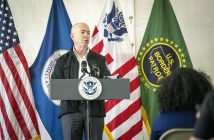Struggling to win the hearts and minds of Americans, refugee transplanters are now going for the wallet.
A leaked Department of Health and Human Services draft report suggests that refugees in the U.S. yield $63 billion in “revenues” over 10 years, exceeding the cost of related government services.
With a windfall like that, the Trump administration should roll out the welcome mat. The world’s huddled masses will knock down the federal deficit in no time.
But, seriously, no one – including the HHS bean counters — believes the numbers. As the Washington Post gently put it: “The HHS report is open about the shortcomings in the data and uncertainties in the estimates.”
While crediting taxes paid by refugees, HHS fails to detail the cost of public goods, such as police protection, paid with those taxes. It does not fully account for the full range of refugee-related expenses incurred by local and state agencies.
Fact is, no one knows exactly what those expenses are. HHS says the average per-capita annual cost of resettling a refugee is $7,134. The Center for Immigration Studies pegs it at $12,874. Both figures are lowball estimates.
If there’s agreement on anything, it’s the United Nations’ position that transplanting global refugees in the U.S. is multiple times more expensive than settling them closer to their homelands.
The cost of settling refugees in foreign nations and alien societies thousands of miles from home is exacerbated by the fact that refugees typically hail from underdeveloped countries wracked by violence and, as a result, are frequently poorly educated and poorly skilled.
Such socio-cultural disadvantages make it harder – and more costly – for refugees to find their footing in skills-oriented, technology-based economies. “Research also suggests that poorly educated immigrants have, on average, a negative fiscal impact on receiving countries,” the Heritage Foundation concluded this year.
At best, refugees compete with underemployed American citizens for low-pay, low-skill jobs, and drive down wages. At worst, they are costly, disruptive and divisive elements in their new hometowns.
Take Amarillo, Texas, where more than 1,000 Somali refugees have resettled. The local schools are now overloaded with children who can’t speak English. As FAIR has repeatedly shown, it is considerably more expensive to educate limited English proficiency students.
Classrooms dominated by kids who can’t speak English also tend to hold back native English speakers because teachers are focused on bringing foreign-language speakers up to speed before they can teach reading, writing, and arithmetic. “We have 660 (refugee) kids who don’t speak English and the U.S. Department of Education says they have to be at grade level within one year. It’s a ludicrous requirement – they don’t even know how to use the bathroom,” said Mike Harpole, the mayor of the North Texas city.
How do low-skilled, English-challenged refugees who are dependent on public assistance contribute so mightily to the U.S. economy? HHS never really explains that. But one thing is for certain, even if refugees don’t bring dollars into American communities, they put cash in the pockets of deep-state bureaucrats. HHS controls the majority of federal funds earmarked for refugee resettlement (some $1.5 billion in FY 2017). Keeping up the flow of refugees means HHS functionaries stay employed – and won’t have to look for new jobs where someone might actually check their math.





3 Comments
5
The contribution of refugees to the US economy and nation depends on why they came and their socio-economic status. Economic refugees are a burden to the US. Political and other types of non-economic refugees are a positive addition to the US economy because of the circumstances of their background. Many of the Cuban and most Asian refugees are a positive impact to the US economy because of the particular situations. Cubans fleeing to the US were, for the most part, until about 1982 political refugees. Cuba sent their top economic classes, professionals, businessmen, educators, artists, skilled workers (plumbers, electricians, mechanics, construction workers, fishermen, farmers, etc) because of communism, confiscation of private property and total control of the economy and political activities. Similar with many Asian refugees who were highly educated and fleeing communist regimes. Many Mexican, Central America and many other Latin refugees, except for many Venezuelan and Nicaraguans, which were political refugees, were from low class socio-economic levels, without much education, low or no skills and poverty ridden.
Everywhere Somalis are settled their welfare rates remain high for decades. Maine for example. I was reading some propaganda report about the city of Lewiston and how they “revitalized” it. No wonder. They are spending money provided by the taxpayers. I was also reading about how many of the second generation in Minnesota were “alienated” and thus some become radicalized. So their parents come here from some third world hellhole and the children are given every advantage and they hate us for it. There’s a new NBC survey that shows a majority of white millenials think Democrats don’t care about them. This is, hello, what the party doesn’t get. When you insist that “white privilege” is the problem with America, don’t be surprised when they turn elsewhere to people like Trump even if they disagree with him on a lot of things. At least he doesn’t call you deplorable.